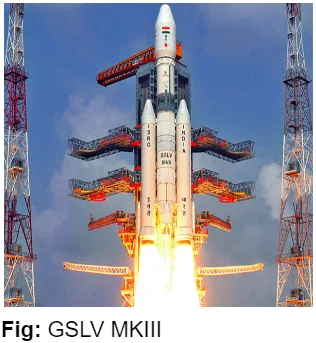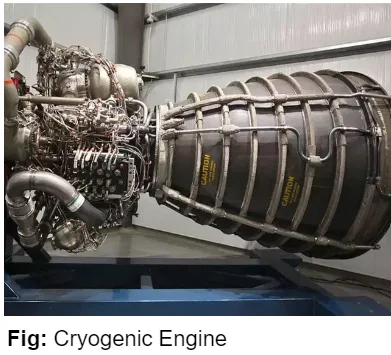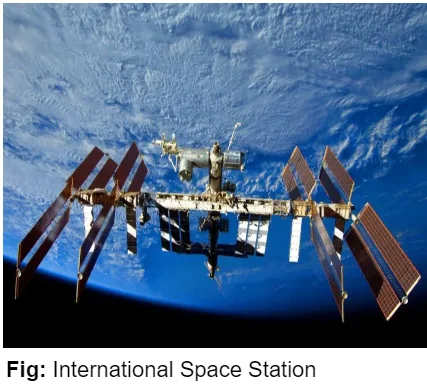India’s space program, led by the Indian Space Research Organisation (ISRO), has developed a range of launch vehicles to deploy satellites into space. These include the Polar Satellite Launch Vehicle (PSLV), the Geosynchronous Satellite Launch Vehicle (GSLV), and the cost-effective Small Satellite Launch Vehicle (SSLV), along with advanced propulsion technologies like cryogenic engines. Additionally, India is making significant strides towards launching its own space station by 2030.
Geosynchronous Satellite Launch Vehicle (GSLV)
Three 3 Stage Vehicle: GSLV is a 3-stage Launch vehicle with solid fuel in the 1st stage, liquid in the 2nd stage and cryogenic in the 3rd stage.
-
- Capability and Purpose: It was developed primarily to launch communication satellites (INSAT Series) of 2.5-tonne class in Geostationary Transfer Orbit and about 4.5 tons class in Low Earth Orbit.
- GSLV Mk II: This is the largest launch vehicle developed by India, which is currently in operation.
-
- This fourth-generation launch vehicle is a three-stage vehicle with four liquid strap-ons.
- The indigenously developed Cryogenic Upper Stage (CUS) forms the third stage of GSLV Mk II.
- Liftoff Mass: 4.14 tones.
- GSLV Mk III: This is a 3-stage heavy-lift rocket with an indigenous cryogenic engine in the 3rd stage.

-
- Also known as ISRO’s Fat Boy is designed to carry 4-ton class of satellites into Geosynchronous Transfer Orbit (GTO) or about 10 tons to Low Earth Orbit (LEO), which is about twice the capability of the GSLV Mk II.
- Notable Launches: injected Chandrayaan-2, India’s second Lunar Mission, into Earth Parking Orbit on July 22, 2019, from Satish Dhawan Space Centre, Sriharikota.
- Further, India’s first human space flight Gaganyaan to be launched using GSLV Mk III in 2022.
Small Satellite Launch Vehicle (SSLV)
Design for Small Satellite Launch: Designed by ISRO’s Vikram Sarabhai Space Centre, to launch payload capacity of 500 kg to Low Earth orbit & 300 kg to Sun-synchronous orbit for launching small satellites.
- Unlike the PSLV and GSLV, the SSLV can be assembled both vertically and horizontally.
- Objective: to commercially launch small satellites at a lower price and higher launch rate as compared to PSLV.
- Propulsion System: The first three stages of the vehicle will use a solid propellant, with a fourth stage being a velocity-trimming module.
Sounding Rockets
Purpose and Usage: Sounding rockets are one or two stage solid propellant rockets used for probing the upper atmospheric regions and for space research.
- They also serve as easily affordable platforms to test or prove prototypes of new components or subsystems intended for use in launch vehicles and satellites.
- First Sounding Rocket Launch: The launch of the first sounding rocket from Thumba near Thiruvananthapuram, Kerala on 21 November 1963, marked the beginning of the Indian Space Programme.
- Benefits: Sounding rockets made it possible to probe the atmosphere in situ using rocket-borne instrumentation.
Rocket Fuel
Towards More Cleaner Fuel: The Indian Space Research Organisation (ISRO) is using the very poisonous and corrosive fuel UDMH (Unsymmetrical Di-Methyl Hydrazine), combined with the oxidiser nitrogen Tetroxide.
- This is referred to as a “dirty combo.”
- Global Shift to Cleaner Fuels: Other space programmes throughout the world have switched to a cleaner and greener fuel, liquid methane or kerosene.
- Need for Cryogenic Engines: Changing to liquid methane would need the usage of a cryogenic engine, as any gas must be stored at extremely low temperatures to remain liquefied.
Propellant Used in Rocket
Propellant: It is a chemical mixture that comprises a fuel and an oxidizer that is burned to provide thrust in rockets.
- Fuel for Propulsion: For propulsion, fuel is a substance that burns when mixed with an oxidizer.
- Oxidizer Function: The oxidizer is a substance that releases oxygen in order to be combined with a fuel.
- Mixture Ratio: The mixture ratio is the proportion of oxidizer to fuel.
- Propellant Condition Classification: The condition of a propellant is classified as liquid, solid, or hybrid.
- Liquid Propellant: The fuel and oxidizer are stored separately in a liquid propellant rocket and delivered to a combustion chamber by a system of pipes, valves, and turbopumps, where they are mixed and burned to produce thrust.
- Cryogenic Propellants: These are liquefied gases kept at extremely low temperatures, with the most common fuel being liquid hydrogen (LH2) and the oxidizer being liquid oxygen (LO2 or LOX).
- At temperatures of -253 C (-423 F), hydrogen remains liquid, while oxygen remains liquid at temperatures of -183 C. (-297 F).
- Solid Propellant Rockets: These are the most basic of rocket designs.
- They are made of a steel casing loaded with a mixture of solid compounds (fuel and oxidizer) that burn rapidly and produce thrust by ejecting hot gases from a nozzle.
- Hybrid Propellant Engines: These are a type of engine that falls somewhere between solid and liquid propellant engines.
- One of the components is solid, which is generally the fuel, and the other is liquid,which is usually the oxidizer.
Cryogenic Engine
Fuel Used: A cryogenic rocket engine uses a cryogenic fuel or oxidizer, which means the fuel or oxidizer (or both) are gases that have been liquefied and kept at extremely low temperatures.

- Efficiency and Thrust: In comparison to solid and earth-storable liquid propellant rocket stages, cryogenic rocket stages are more efficient and produce greater thrust per kilogramme of propellant burned.
Air Breathing Engines
Types of Air-Breathing Engines: In the burning of fuel, air-breathing engines utilise oxygen from the environment.
- The turbojet, turboprop, ramjet, and pulse-jet are among them.
- Other methods in use are heavier, less efficient, and less cost-effective than this one.
- Ramjet: A ramjet is a type of air-breathing jet engine that compresses incoming air for combustion without the use of a revolving compressor.
-
- At supersonic speeds, ramjets are most efficient, but at hypersonic speeds, they are ineffective.
- Scramjet: A scramjet engine is superior to a ramjet engine because it can run at hypersonic speeds while still allowing supersonic combustion.
- Dual Mode Ramjet (DMRJ): It is a kind of jet engine that converts from a ramjet to a scramjet over the Mach 4-8 range, allowing it to function efficiently in both subsonic and supersonic combustion modes.
International Space Station
Location: The International Space Station (ISS) is a low-Earth-orbiting, habitable artificial satellite.

- Space Agencies Involved: NASA (United States), Roscosmos (Russia), JAXA (Japan), ESA (Europe), and CSA (Canada) are among the five space agencies involved in the project.
- Research and Environment: The station serves as a microgravity and space environment research laboratory, where astrobiology, astronomy, meteorology, physics, and other fields are studied.
- On board the ISS, the atmosphere is identical to that of Earth.
Recent Developments
- India is seeking to launch its own space station by 2030, joining the league of US, Russia, and China to an elite space club.
- China has launched an unmanned module of its permanent space station, which it intends to finish by the end of 2022.
- The module, called Tianhe or Harmony of the Heavens was launched on China’s heaviest carrier rocket, the Long March 5B.
|
Types of Launch Vehicles by ISRO
Launchers or Launch Vehicles are used to carry spacecraft to space. India has two operational launchers: Polar Satellite Launch Vehicle (PSLV) and Geosynchronous Satellite Launch Vehicle (GSLV).[UPSC 2018]
-
- In India there are 4 generations of launch vehicles:
- 1st Generation: Satellite launch vehicles.
- 2nd generation: Augmented satellite launch vehicle
- 3rd generation: Polar satellite launch vehicle(PSLV)
- 4th Generation: Geosynchronous satellite launch vehicle(GSLV)
- PSLV can deliver payloads of up to:
-
- 3,250kg to LEO (Low Earth Orbit)
- 1600 kg to SSO (Sun Synchronous orbit)
- 1400 kg to GTO (Geosynchronous Transfer Orbit)
- Notable Launches by the PSLV: Chandrayaan-1 in 2008 and Mangalyaan/Mars Orbiter Mission in 2013.
- PSLV-C37: launched 104 satellites on February 15, 2017, the highest number of satellites launched in a single flight so far.
Conclusion
ISRO’s diverse range of launch vehicles highlights India’s growing capabilities in space technology, enabling successful missions such as Chandrayaan-1, Mangalyaan, and Chandrayaan-2.
- With ongoing developments in propulsion systems and plans for a space station, India is poised to further solidify its position in the global space community.
- The continuous innovation and successful deployment of satellites underline ISRO’s commitment to advancing space exploration and research.
![]() June 17, 2024
June 17, 2024
![]() 2451
2451
![]() 0
0


